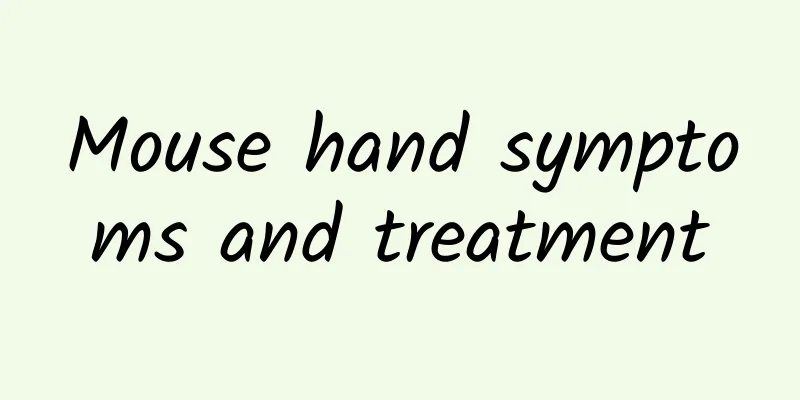What are the symptoms of infant brain nerve damage

|
For infants, if the brain nerves are damaged, the harm is particularly great, often causing central nervous movement disorders, leading to mental retardation in the children, epilepsy, hearing and vision problems, etc. Such children often show the inability to suck, or suck weakly, are usually quiet, cry weakly, etc. What are the early symptoms of brain damage in infants? ① In the neonatal period (less than one month), the child cannot suck or sucks weakly or refuses to breastfeed; ② The child is quiet and does not move much, cries weakly or cries continuously and is difficult to comfort; ③ Stiffness, especially when dressing, it is difficult to put the upper limbs into the cuffs; when changing diapers, the thighs are not easy to abduct (open); ④ The child’s whole body becomes stiff and tense, and the head is dorsiflexed or tilted to one side. ⑤ When the child is 1 to 3 months old, he or she may clench his or her fists, retract his or her thumbs, not pay attention to others, have a dull facial expression, and cannot raise his or her head when lying prone; ⑥ At 4 to 5 months, the eyes are not flexible, they will not follow objects, they will not pay attention to people, their expressions are dull, they will not turn over, their heads will be less than 90 degrees when lying prone, they will not actively reach out to grab objects or only use one hand to grab objects; ⑦ After 6 months, abnormal postures are obvious, such as hands still being clenched into fists, toes touching the ground, lower limbs crossing, etc., accompanied by obvious motor development retardation. Early intervention 1. Visual stimulation: Newborns can be guided to look in all directions with brightly colored toys and the smiling faces of their parents talking to them, several times a day for about 1 minute each time. For patients with obvious visual pathway damage confirmed by visual evoked potential or optic nerve hypoplasia or atrophy as confirmed by fundus examination, pupillary light reflex stimulation is added, with the ratio of light to no light being 1 to 5 seconds:5 seconds each time, 5 times per group, 30 to 60 groups per day, with an interval between groups greater than 5 minutes. This method should be performed under the guidance of an experienced physician and should not cause photodamage to the macula. After sitting down, you can use high-contrast black and white pictures and word cards to stimulate the vision at a faster speed, which can improve the ability to focus. 2. Auditory stimulation: The sound of parents’ voices is the best auditory stimulation. Parents should speak to their babies in a louder voice several times a day. If the auditory evoked potential abnormalities are more obvious, other soft sound stimulations can be added, such as the sound of shaking a plastic box filled with beans, several times each time, 30 to 60 times a day. 3. Skin sensory stimulation: About 80% of children with brain damage have long latency and low amplitude of somatosensory evoked potentials. Skin stimulation such as touching and brushing can promote recovery from brain damage. Touching, soft-bristled brushing, sponging, and light tapping are used for those with high muscle tone, several times a day, each time for 5 to 10 minutes. People with low muscle tone can use a hard-bristled brush, patting with hollow palms, cold or hot water stimulation, etc. Chiropractic is an effective method for comprehensive conditioning through skin stimulation. 4. Crawling training: American doctors Temple F, Doman RJ and Doman G pointed out through research that in the process of human individual development, there is a repetition of the characteristics of the phylogenetic evolution process. In the process of motor development of infants from crawling to kneeling and crawling on their hands and knees, and then to standing and walking, the corresponding development of the central nervous system is from the pons to the midbrain, and then to the cerebral cortex. Brain damage in the corresponding parts may have corresponding movement disorders. Brain damage at the next level can affect the motor functions of the upper levels. Therefore, those who cannot walk or have abnormal walking posture should start training from crawling. |
<<: What are the symptoms of wisdom tooth extraction wound infection
>>: What are the symptoms of blood stasis?
Recommend
What foods can cause miscarriage?
During pregnancy, diet is very important for preg...
What causes unexplained purple skin?
Because we are of the yellow race, our skin color...
Common problems with fallopian tubes and methods of regulating fallopian tubes
The fallopian tube is an important component of t...
Is long-term insulin injection harmful to the body?
For diabetic patients, long-term insulin injectio...
What to do if breast milk is cold
Everyone knows that breastfeeding is the safest, ...
Treatment of heel pain in the elderly
As we age, the body's defense and self-healin...
Spleen deficiency can be relieved by massaging these acupoints
Nowadays, more and more people recognize the meth...
Buried suture double eyelid swelling reduction
Buried suture double eyelid is a relatively commo...
Migraine Causes and Treatments
Nowadays, we need to face a lot of pressure in li...
What to do if you have diarrhea
Diarrhea is a common symptom among children. It r...
Tomatoes for prostatitis
For some patients with prostatitis, while taking ...
Purple flower bitter vegetable for treating cholecystitis
Dandelion is a common wild vegetable in the north...
Sudden blockage in one ear
If one ear suddenly feels blocked, you should pay...
What are the symptoms of insufficient qi and blood?
If a woman wants to have a good complexion, she m...
The efficacy and role of Nianjian
In the plant kingdom, many plants can actually be...









